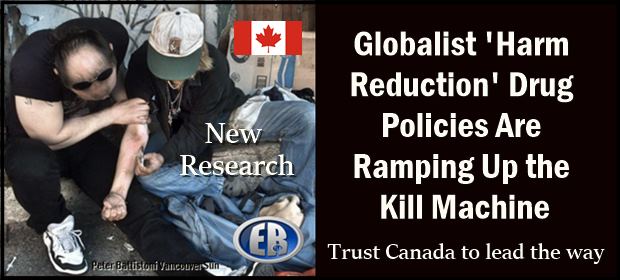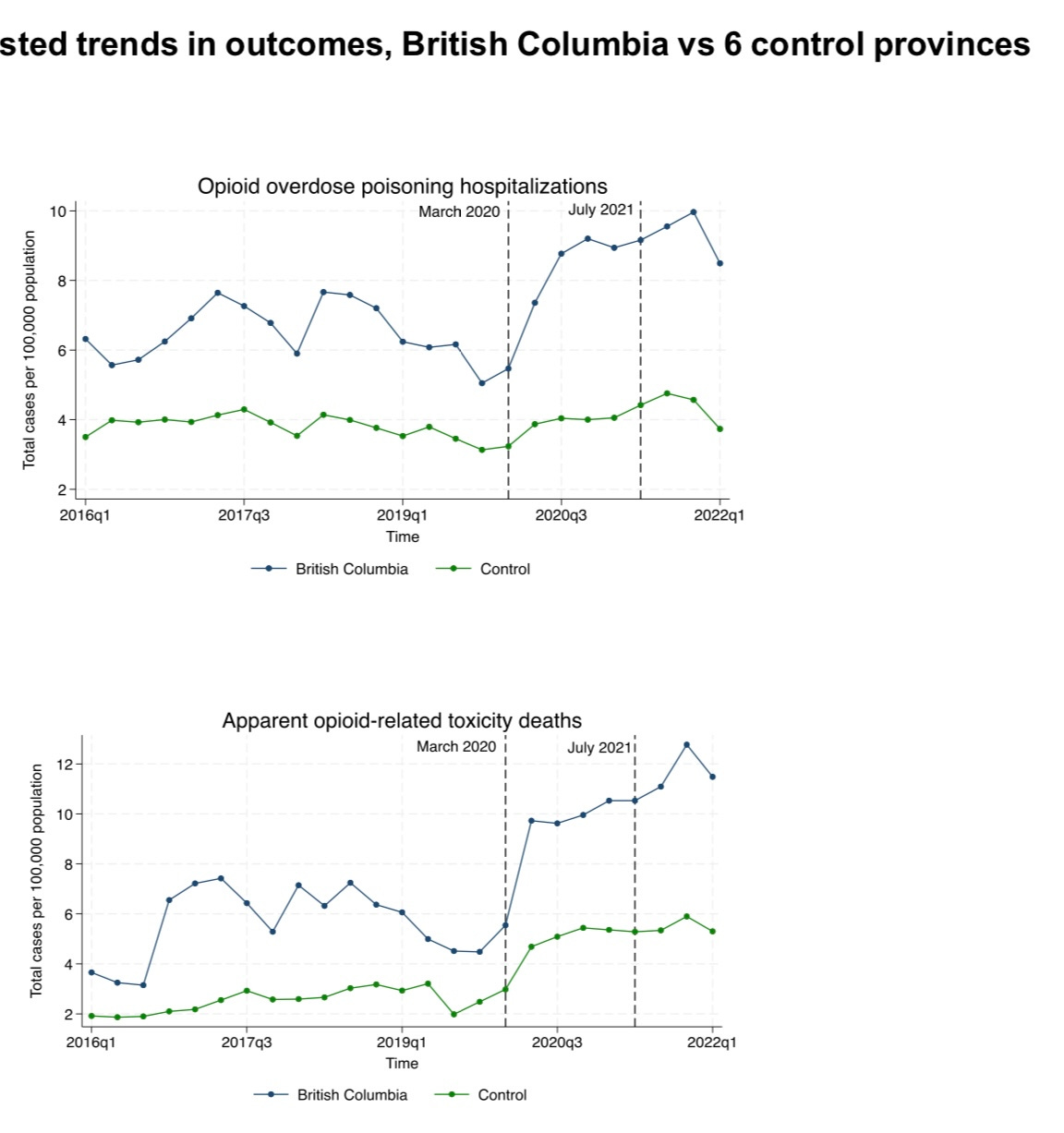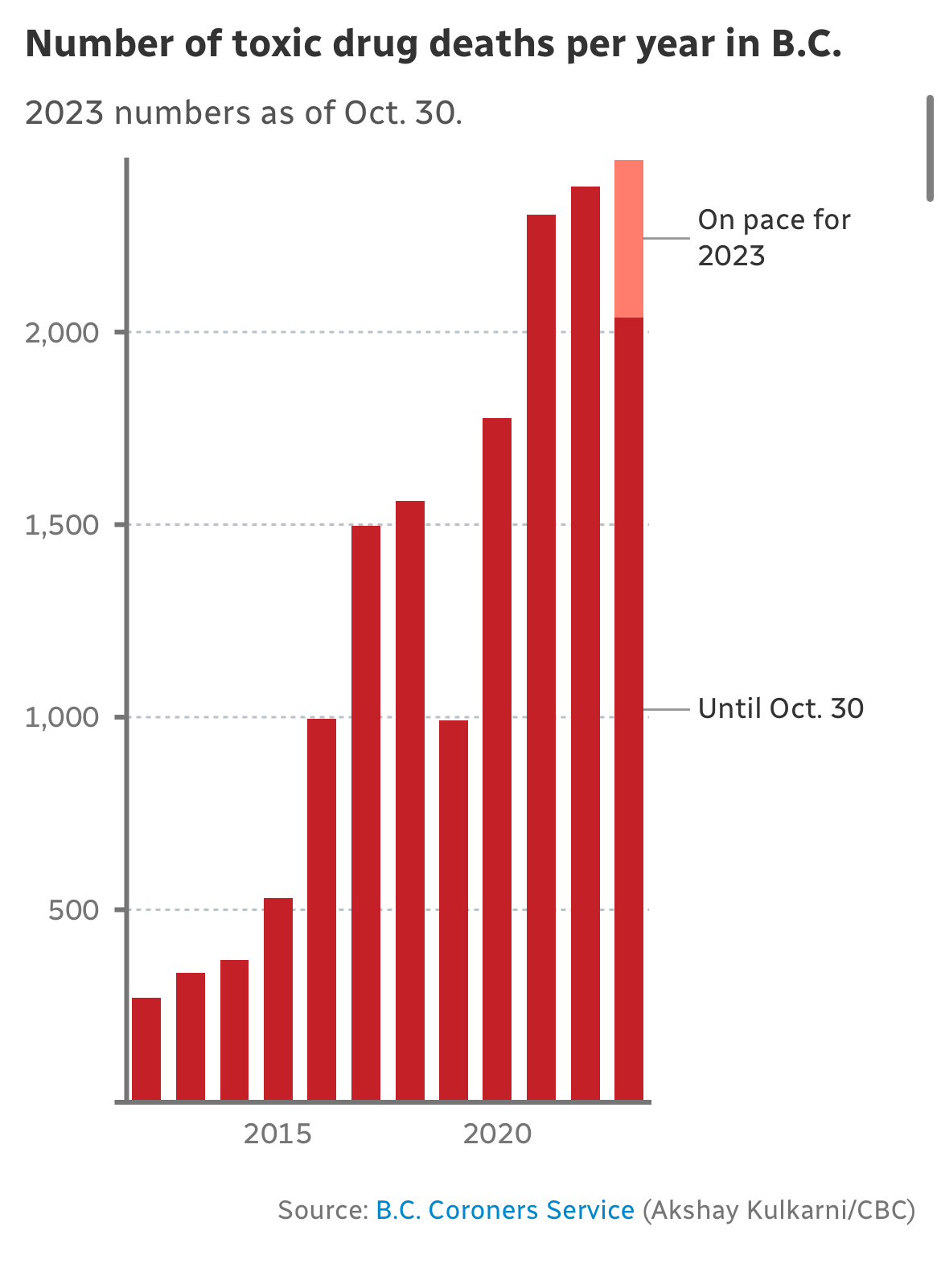
ER Editor: Vancouver, BC is a city we are intimately acquainted with, and a city that has been clearly targeted by the globalists for rot and destruction. Which has been accomplished with a drug policy handed down by Trudeau’s feds, among other things. Vancouver is one of the globalist C40 cities (find Vancouver and other cities here).
See the Vancouver is Dying documentary by Aaron Gunn
Kudos to Alex Berenson for dropping the paywall on the article below.
***
Berenson notes that the globalists (he doesn’t use that word) want to apply this death-causing ‘harm reduction’ drug policy WORLDWIDE. People we know here in Paris, working in drug programs, are looking with horror at Vancouver, fearing that their situation will arrive here.
It is relevant to focus on Vancouver (instead of just saying ‘British Columbia’, as Berenson does) because the drug problem, that once was taken off the streets, has come back with a vengeance, creating encampments on sidewalks of drug addicts in what is known as the Downtown Eastside. How? Because the Feds decided to hand out hard drugs for FREE. This has probably had the overall spillover effect of plummeting real estate values. Remember how repeated lockdowns put small business owners out of business? Leaving their property to be scooped up at rock bottom prices? The Downtown Eastside, where the drug problem abides, abuts ritzy downtown Vancouver, similarly leaving a vast area of commercial real estate in a prime location to drop year on year in value. A period of attrition would empty out this area of small business owners. The globalists know what they’re doing.
********
Yet again, the better we get at “harm reduction,” the more people overdose and die
Four years ago, the Canadian province of British Columbia gave addicts legal access to fentanyl and other opioids, hoping to reduce hospitalizations and deaths. The results have been catastrophic.
ALEX BERENSON
(NOTE TO READERS – ONCE AGAIN I AM DROPPING THE PAYWALL EARLY, THIS STORY IS JUST TOO IMPORTANT. I HOPE YOU WILL CHOOSE TO SUBSCRIBE ANYWAY.)
In 2020, the Canadian province of British Columbia took a big step towards drug legalization, letting addicts have medical prescriptions for opioids, including fentanyl.
British Columbia’s “Safer Opioid Supply” program included lenient rules to encourage users to join. Doctors could write prescriptions even for people at high risk of overdose. Addicts did not have to enter treatment or even agree to counseling to participate. Canada’s national health insurance program even paid for the drugs.
As Canada says in its official webpage on “safer supply” programs:
[They] do not necessarily focus on stopping drug use. Instead, they focus on meeting the existing needs of people who use drugs.
With the program, British Columbia – which includes Vancouver, a city drug legalization advocates often tout as a model – became the first state or province anywhere to allow widespread medical opioid prescriptions for addicts.
But, like British Columbia’s earlier efforts at what advocates like to call “harm reduction,” the plan has failed catastrophically, a new study shows.
In a report Jan. 16 in JAMA Internal Medicine, Canadian researchers found opioid overdose hospitalizations and deaths have soared in British Columbia since 2020.
The rise occurred both in absolute numbers and compared to other Canadian provinces that did not legalize opioid prescriptions.
The researchers first compared British Columbia to two small nearby provinces (ER: Saskatchewan and Manitoba. They’re not ‘small’ and they’re not ‘nearby’). But they found similar results when they checked bigger provinces too, including Ontario, Canada’s largest.
—
*ER: Notice this program began in March 2020, when everybody was put into an illegal lockdown over an alleged virus circulating.
(Oh, Canada. The program began in March 2020* and was expanded in July 2021. In both graphs, the blue line shows overdoses in British Columbia, and the green a group of “control provinces” did not legalize opioid prescriptions for addicts.)

SOURCE (page 4)
—
For hospitalizations, the rising gap between British Columbia and the other provinces reached statistical significance, meaning the change probably was not due to chance.
Overdose deaths also jumped faster in British Columbia than elsewhere in Canada. In 2018 and 2019, the province had about 1,200 opioid deaths a year. The rest of Canada had about 2,800.
By 2022, deaths in British Columbia had risen roughly 100 percent, to 2,400. In the rest of Canada, deaths rose about 80 percent to 5,100. However, that difference did not reach statistical significance, meaning it could have been due to chance.
Those numbers are more horrific than they seem, because British Columbia is relatively small by American standards. With 5 million people, it would rank as the 25th most-populated American state, just behind Alabama.
The 7,200 opioid overdose deaths British Columbia suffered from 2021 through 2023 are thus suffered the equivalent of about 475,000 deaths in the United States. And the figure does not include overdoses from cocaine or other drugs like Valium.
Put another way, people in British Columbia are dying from opioid overdose at roughly double the rate in the United States, where overdoses are rightly viewed as a national emergency. If British Columbia were a state, it would have the second-highest rate of opioid overdose deaths, behind only West Virginia.
—
What legalization advocates should find particularly disturbing about the catastrophe in British Columbia is that the province represents a test case for the strategies they want to pursue worldwide.
For over a decade, British Columbia and Vancouver have taken a very permissive stance on opioid use. Local and provincial governments have focused their energies on “harm reduction” – the view that use cannot be stopped and that efforts to discourage or stigmatize it, much less punish it as criminal activity, only increase its risks.
The city and province have aggressively promoted the use of naloxone to revive people who suffered overdoses. They make “medically assisted treatment” – which basically means encouraging addicts to use less dangerous opioids rather than trying to quit – widely available. They have “supervised consumption sites,” where people can smoke or inject drugs while a nurse watches. (ER: This is an old program that gave users a clean needle to be used once under medical supervision. It removed addicts shooting up with contaminated needles in local alleyways and made the surrounding community safer.) Last year, the province even gave public money to a group called the Drug User Liberation Front, which then bought cocaine, methamphetamine, and heroin, to give to users. (ER: Newer programs have indeed just starting dishing out hard drugs for free. Which not only creates more users but permits some to take their drugs and re-sell them. Aaron Gunn covers this in his documentaries.)
In his book Chasing The Scream, which was published in January 2015 and has become the modern bible of drug legalization advocacy, the British journalist Johann Hari lauded Vancouver for the way it supported supposedly safe use of drugs.
After a year and a half of meeting victims of this war and feeling more and more angry and depressed, Vancouver had given me an itchy sense of hope. I had learned… that things could get dramatically better if people organized and demanded it.
The result of all of those efforts? In 2014, British Columbia had 366 opioid overdose deaths.
Last year, it had almost 2,500.
—
(Progress as promised)

—
Vancouver’s health bureaucrats have come up with one effective response to the crisis.
They don’t use the word “overdose” anymore.
In a masterpiece of Orwellian euphemism, they refer to “poisoning” deaths from “toxic” and “unregulated” drugs, as if “regulated” fentanyl cannot kill, as if the explosive growth in medically prescribed opioids in the United States and Canada two decades ago did not set the stage for the mountains of human misery ever since.
In the short run – the very short run – harm reduction programs may save users from overdoses and death, though even in that case the evidence is not as clear as drug advocates pretend.
Notably, in a 2018 paper, two well-regarded social scientists found that broadening access to naloxone “led to more opioid-related emergency room visits and more opioid-related theft, with no net measurable reduction in opioid-related mortality.” As the researchers wrote later for the Brookings Institution, when users are aware naloxone is available, they may use more and more potent opioids.
But the paper – like other efforts to detail the potential real-world costs of making drugs more accessible or more socially acceptable – generated huge pushback among the legalization community.
Because for drug advocates, the answer to the failures of “harm reduction” is always more of the same. About 12 months ago, British Columbia fully decriminalized the possession and use of heroin, cocaine, and fentanyl.
But with death rates continuing to rise, advocates argued last fall addicts be allowed to receive drugs without a prescription – a proposal that essentially would end any restrictions on state-funded drug use. (The government rejected the proposal.)

—
What no one in the harm reduction community will admit is that societies can control drug use.
They can’t eliminate it entirely, but they can make it more or less acceptable by highlighting its harms and making users legally responsible. Rates of drunk driving and tobacco smoking have plunged in the United States, thanks to stigmatization, increased taxes, and police enforcement against impaired drivers.
Meanwhile, British Columbia has gone so far the other way that users have an actual union of sorts, the Vancouver Area Network of Drug Users.
But every effort at harm reduction – even if well-intentioned – sends the opposite message, that the danger of opioids and cocaine can be managed and are not inherent to the substances themselves.
British Columbia’s experience proves the opposite.
How many deaths will it take for the harm reducers to admit the truth?
Source
************

••••
The Liberty Beacon Project is now expanding at a near exponential rate, and for this we are grateful and excited! But we must also be practical. For 7 years we have not asked for any donations, and have built this project with our own funds as we grew. We are now experiencing ever increasing growing pains due to the large number of websites and projects we represent. So we have just installed donation buttons on our websites and ask that you consider this when you visit them. Nothing is too small. We thank you for all your support and your considerations … (TLB)
••••
Comment Policy: As a privately owned web site, we reserve the right to remove comments that contain spam, advertising, vulgarity, threats of violence, racism, or personal/abusive attacks on other users. This also applies to trolling, the use of more than one alias, or just intentional mischief. Enforcement of this policy is at the discretion of this websites administrators. Repeat offenders may be blocked or permanently banned without prior warning.
••••
Disclaimer: TLB websites contain copyrighted material the use of which has not always been specifically authorized by the copyright owner. We are making such material available to our readers under the provisions of “fair use” in an effort to advance a better understanding of political, health, economic and social issues. The material on this site is distributed without profit to those who have expressed a prior interest in receiving it for research and educational purposes. If you wish to use copyrighted material for purposes other than “fair use” you must request permission from the copyright owner.
••••
Disclaimer: The information and opinions shared are for informational purposes only including, but not limited to, text, graphics, images and other material are not intended as medical advice or instruction. Nothing mentioned is intended to be a substitute for professional medical advice, diagnosis or treatment.





They always tell us what they’re doing…..
M. van der Kemp :
Nice catch on the ‘smart’ shops..! Lol
Maybe Vancouver should just call their supply of drugs ‘Smart Shots’ and quit pretending they care about addicts as they enforce the globalist culling efforts.
Great point.
Legalising drugs and giving “safe” drug-replacement on the tax-payer’s behalf is another Dutch invention.
Since the 80’s people fom all over the world have been coming to The Netherlands to smoke weed legally in coffee shops, do mushroom-trips in “smart shops” (what’s in the name). And the heavy-drug users, like cocaine and heroine, could enroll in government programs for free Methadon.
Crime rates have dropped though. But that’s mostly because it has been made almost impossible to report a crime.